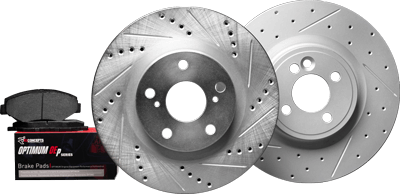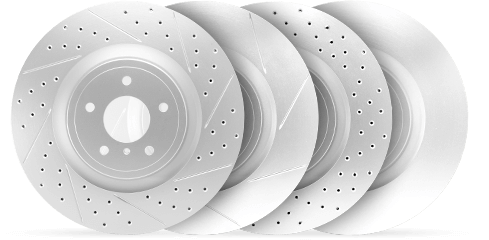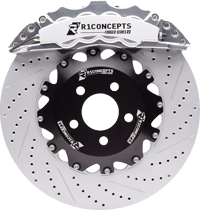Recognizing the symptoms of a bad proportioning valve is essential for maintaining the braking performance of your vehicle. The proportioning valve is pivotal in adjusting brake pressure between the front and rear brakes, and its failure can lead to rear wheel lockup, uneven braking, and excessive front-end dive during braking. This article will guide you through identifying these symptoms without getting lost in technical jargon, helping you take informed steps towards repair.
Key Takeaways
A failing proportioning valve can lead to critical brake issues like rear wheel lockup, uneven performance with vehicle pull, and excessive front-end dive, which compromise vehicle safety and control.
Brake system problems can be confused with proportioning valve failures; other components like worn brake pads, air in the brake lines, or damaged brake system parts can exhibit similar symptoms and should be properly diagnosed.
Ignoring the symptoms of a bad proportioning valve can result in significant safety risks and potentially catastrophic consequences; prompt replacement by a qualified professional is crucial for vehicular safety.
Identifying the Culprit: Is Your Proportioning Valve to Blame?
The proportioning valve is a crucial component is responsible for modulating pressure to maintain a balance between the front and rear brakes, thereby playing an integral role in averting wheel lock-up or loss of control when you apply significant force on the brake pedal. When this valve malfunctions, there could be problems we can anticipate.
It’s important to recognize these symptoms accurately because failing to do so could lead down a path of unnecessary parts replacement and ignored issues within your brake system that require attention.
Rear Wheel Lockup During Heavy Braking
Imagine you’re driving on a wet highway when suddenly, the vehicle in front of you stops abruptly. Your instinctive response is to slam on the brake pedal, but rather than coming to a gradual halt, your rear wheels seize up and your car starts to skid uncontrollably. This frightening event often signifies that there’s an issue with the proportioning valve which can result in the locking up of both rear wheels during emergency braking due to improper distribution of brake fluid pressure.
At times, if this valve becomes obstructed, it may lead to constant engagement of the rear brakes causing them to lock even without pressing down on the brake pedal actively. Not only does this represent a severe hazard for road safety, but also increases chances for loss-of-control incidents leading to possible skids. The tendency for vehicles’ rear wheel lockup serves as one of the primary indicators pointing toward malfunctioning proportioning valves and is cause enough for urgent examination and repair.
Uneven Braking Performance and Vehicle Pull
When you experience uneven braking, such as your vehicle veering to one side while coming to a stop, it may be an indication that the proportioning valve in your brake system is not functioning properly. This can lead to challenges in controlling the vehicle and increase the danger during urgent braking situations.
Problems with a brake proportioning valve might manifest through:
A longer distance needed for stopping
The tendency of the vehicle to drift toward one direction when applying brakes
Premature wear on rear brakes compared with front ones
Presence of contaminants within various components of the brake system
These evident symptoms suggest issues related specifically to irregular performance of brakes due often could point towards troubles with your car’s proportioning valve which demands prompt evaluation and repair if necessary.
Excessive Front-End Dive
The front-end dive is a noticeable tilting of the vehicle’s nose towards the ground when braking, indicating a potential imbalance in brake pressure distribution often linked to a malfunctioning proportioning valve. This issue suggests that there’s an unequal distribution of brake pressure between the front and rear brakes, which is typically a sign that the proportioning valve isn’t functioning correctly.
If this disproportionate braking force arise due to excessive reduction or blockage within the proportioning valve affecting rear brake pressure, it can lead to an over-reliance on your vehicle’s front brakes for stopping power. Such imbalances compromise both handling and safety aspects of driving, underscoring why prompt attention should be given when encountering these symptoms during braking maneuvers.
The Risks of Ignoring Proportioning Valve Problems
Neglecting issues with the proportioning valve is tantamount to gambling with your vehicle’s safety. When a brake proportioning valve fails, it disrupts the distribution of fluid within the brake system, leading to serious performance problems. Problems arising from a faulty proportioning valve include:
Imbalanced braking
Lockup of rear wheels
Extended stopping distances
Potential for complete failure of the brake system
These braking malfunctions can dramatically increase the chances of losing control over your vehicle and experiencing skids at the rear end during intense braking or while maneuvering curves. The risks involved in overlooking a malfunctioning proportioning valve are significant and necessitate prompt attention to repair in order to mitigate elevated collision dangers.
Can You Lose Control of Your Car?
If your vehicle’s proportioning valve is malfunctioning, it may lead to erratic and hazardous braking performance. Such a defect increases the likelihood of losing control over the vehicle and can precipitate traffic mishaps. Symptoms indicating a failing proportioning valve should be taken seriously, as they pose risks not only to those within the car, but also endanger other road users by compromising overall safety.
For assurance of roadworthiness and occupant protection, immediate action must be taken when dealing with a defective proportioning valve. It’s imperative that you have your car examined by an expert mechanic who can replace the faulty component without delay. Vehicle safety isn’t something one should risk. Hence attending to such issues promptly is crucial for maintaining safe driving conditions.
Urgency of Repair: Assessing the Need for Immediate Action
It is essential to immediately address the issue of a failing proportioning valve due to its critical role in ensuring vehicle safety. These valves, crucial for balanced braking, are not manufactured with repair options in mind, but rather are intended solely for replacement when they fail. Opting for makeshift solutions like applying thread sealer on leaky valves can lead to unreliable results and should be avoided.
Should you encounter issues with your proportioning valve, it is vital to have it inspected and replaced by someone qualified without delay. Proportioning valves directly impacts the effectiveness and safety of a vehicle’s braking system. Hence any malfunctions must be rectified swiftly. Neglecting such defects poses unacceptable risks that could compromise vehicular safety.
Cost Considerations for Proportioning Valve Replacement
Swapping out a defective proportioning valve is crucial for both functional and economic reasons. The replacement cost of this valve fluctuates considerably depending on the make and model of the vehicle, as well as the intricacies involved in its brake system. When changing this part, it’s typically suggested to also change the brake fluid, which could contribute to an increased overall service charge.
Even though these expenses might seem substantial, they are minimal compared to what one might incur from having to replace an entire brake line or facing dire outcomes due to neglecting such issues within the braking system.
Is Proportioning Valve Replacement an Expensive Endeavor?
Considering the expenses involved in repairing various components of a brake system, it’s important to note that the replacement cost for a proportioning valve often falls somewhere between minor fixes and major overhauls. For example, it tends to be more affordable than replacing an anti lock braking system module or servicing a master cylinder, but may cost more than changing brake pads. Compared with complete replacements of brake lines, installing a new proportioning valve is considered an intermediate repair in terms of expense.
When budgeting for the replacement of a proportioning valve, factors influencing price include not only the cost of the valve itself, but also labor fees and potentially additional necessities such as parts or fluids. While costs are significant considerations when addressing vehicle repairs like these ones involving brakes systems on cars where proper functioning could mean life-saving circumstances hence must always take precedence regardless of the financial aspect brought forth by said situation thus prioritizing safety above all else becomes imperative for responsible car ownerships accordingly taking importance into account should never negate acknowledging the essential nature associated with maintaining properly functioning automotive braking mechanisms ultimately.
DIY vs. Professional Repair: Navigating Your Options
If you’re considering fixing a failing proportioning valve on your own, it’s critical to realize that this task necessitates not just mechanical skill and a fundamental grasp of the vehicle’s brake system, but also adherence to procedures specific to your car model. Certain specialized tools are required for this repair job, which includes line wrenches suitable for working with brake lines, flare nut and bleeder wrenches along with fresh brake fluid.
It is paramount that you acquire a proportioning valve that matches the specific type and production year of your vehicle. This ensures both compatibility with your vehicle’s systems and the proper functioning of the associated brake light warning switch.
When to Call in a Mechanic
In situations where safety is paramount, seeking expert assistance is often the best course of action. Proportioning valves are integral to vehicle safety. It’s advisable to have them professionally replaced by a qualified mechanic. Such mechanics are equipped with not only the requisite expertise but also the appropriate tools for an accurate diagnosis and replacement of any malfunctioning valve, ensuring that repairs meet both correct standards and safety requirements.
It’s important to keep in mind that errors made during the replacement of proportioning valves can lead to significant braking problems and jeopardize your well-being while driving. Consequently, if there’s any uncertainty about handling this task yourself, don’t hesitate to enlist professional help. Prioritizing your own security as well as that of fellow road users should always come first.
Temporary Fixes: Do They Exist?
Many car owners wonder if there are makeshift solutions to issues with proportioning valves. Based on our investigations, the response is clear-cut: no temporary remedies for problems related to proportioning valves have been found in existing data.
Considering the vital function these valves serve in maintaining even and secure braking performance, it’s imperative that one consults an expert promptly for a lasting repair upon noticing any indication of malfunction, including complications with the bleeder screw.
Summary
In the complex symphony of a vehicle’s operations, the proportioning valve plays a vital, yet often overlooked, role. Ignoring the symptoms of a failing valve is a dangerous gamble that can jeopardize your safety and that of others on the road. Whether it’s rear wheel lockup, uneven braking performance, or excessive front-end dive, these signs should never be dismissed. Remember, while cost and convenience are considerations, nothing is more valuable than your safety. So, at the first sign of trouble, consult a professional, and ensure your vehicle is in the best shape to take you safely to your destination.
Frequently Asked Questions
How do you unstick a brake proportioning valve?
To release a stuck brake proportioning valve, extract the switch and employ a screwdriver to push it towards the middle, facilitating the bleeding of brakes. The spring within the switch centers this valve by exerting pressure on a cam that’s precision-machined into its core.
Can a bad proportioning valve cause front brakes to drag?
Incorrectly assuming that a faulty proportioning valve can result in the front brakes dragging is misguided. The true culprits of this issue could be rust within caliper bores, brake flex hoses collapsing internally, defects within the master cylinder, or an improperly adjusted brake switch. Not the valve itself.
What will be the effect if the brake system has no proportioning valve?
A properly functioning proportioning valve is essential to ensure that during rapid deceleration, the pressure distributed to the rear brakes doesn’t become excessive. Excessive pressure can lead to a lock-up of the rear brake, which is particularly risky in pickup trucks with light backends where this issue might be more prevalent.
How do you test a proportion valve?
To evaluate the functionality of an aftermarket ADJUSTABLE proportioning valve, incrementally adjust it and execute a sudden stop. Keep fine-tuning until you achieve a setting where the rear wheels cease to lock up prior to the front ones during such abrupt braking maneuvers.
What is a proportioning valve and why is it important?
Essential for maintaining equilibrium between the front and rear brakes, a proportioning valve adjusts the pressure to ensure stable braking performance and avoid skidding or loss of control when applying the brakes forcefully.









